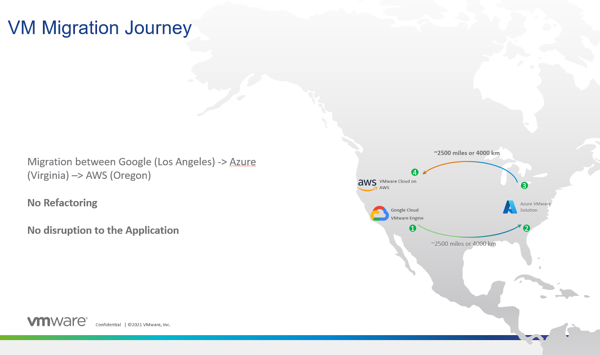Originally posted on VMware Blogs by Emily O’Shaughnessy
Today, most organizations use at least two clouds to run their workloads—and many use three or more. This is either by design or the unintentional result of acquisitions or individual teams choosing different vendors. Either way, multi-cloud provides many advantages, including flexibility, scalability, optimized costs, and better performance.
RedMonk’s Kelly Fitzpatrick talks to VMware’s Marc Fleischmann, CTO, VMware Cloud, and Robert Riemer, VMware Staff Multi-Cloud Architect, about workload portability in a multi-cloud world.
While most cloud providers offer similar functionality, they each have unique value or features that differentiate them to developer or operations teams. By using multiple clouds, organizations can mix and match to take advantage of those strengths and avoid vendor lock-in. This allows teams to focus on specific solutions and outcomes to meet organizational objectives while taking into consideration features that impact management, cost, governance, interoperability and security.
Organizations want and deserve the ability to choose cloud vendors based on their unique needs. Choice and freedom are key, not only in choosing where to run workloads, but also in the ability to move those workloads between clouds as needed.
Workload Migration Drives App Modernization
Workload requirements can change quickly. Having the ability to seamlessly move workloads to the best fitting hyperscaler is important and provides teams with the freedom to choose. Move workloads into the cloud, then back to the on-premises datacenter as needed—all without being tied to a single vendor.
The ability to shift workloads has become increasingly important. In fact, 24% of all workload changes planned for 2022 involve moving the workload to a new platform.1
Additionally, most executives (92%) report that their organization is pursuing app modernization in the first half of 2022, with “app portability between clouds” as the leading driver behind this goal.2
Workload Portability with VMware
VMware delivers consistent infrastructure and operational capabilities across clouds. Tanzu Kubernetes Grid (TKG) and Tanzu Mission Control (TMC) build on that foundation, offering developers and operators a single control point with consistency in cluster management across environments, teams and clouds.
Developers are empowered with self-service access to Kubernetes for running and deploying applications in parallel to operators centrally managing clusters, irrespective of the cloud or platform in which they run.
Organizations are able to provision and attach Kubernetes guest clusters on vSphere, observe and manage from a single control point, automate tasks such as policy management, and extend/connect to public cloud seamlessly all from TMC. This control empowers teams to realize higher levels of developer productivity without compromising operational efficiency or security when using any cloud provider.
Typically, management, security, networking and interoperability are different between clouds, and refactoring is complicated because applications have so many dependencies. VMware makes those dependencies visible, enabling migration without any changes to the application itself.
Workload Migration Demo
To learn more and see an example of workload migration in action, watch What is Multi-Cloud Portability? How to seamlessly move workloads between clouds. This video includes a demo moving workloads using VMware HCX from coast to coast with no refactoring and no disruption to the application.

- Source: VMware FY23 Workloads Tracker, January 2022)
- (Source: VMware FY22 Q4 Executive Pulse, January 2022)








